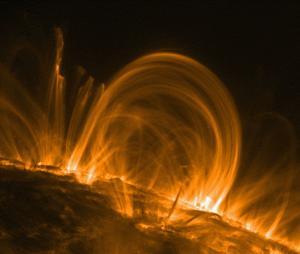
|
| ©NASA |
| Typical image of the solar corona clearly revealing the complex tangle of heated magnetic loops from TRACE. |
Scientists have now made a major breakthrough in understanding this complexity by studying the 'skeleton' of the magnetic field. A team of scientists from St Andrew's University presented the results on 16 April at the Royal Astronomical Society National Astronomy Meeting in Preston. "It is the Sun's magnetic field that dominates the behaviour of the corona and determines its structure", said team member Andrew Haynes, "and our work is a key step forward in understanding its structure".
Until now the complexity of the magnetic field has baffled solar scientists. Professor Eric Priest first proposed the concept of the solar skeleton in 1996. It consists of the key elements on which the complex shape of the magnetic field is built. "We realised", added Dr Clare Parnell, "that by constructing the skeleton of the field, we could unravel this complexity and hopefully determine how the corona is heated".
Dr Parnell and colleagues have managed to develop a computer experiment, which simulates the complex structure of the corona and have found that the coronal heating is focused in specific parts of the skeleton. "In future", she added, "we should be able to compare this type of analysis with dramatic new observations from the recently launched Hinode spacecraft and thereby really nail down the heating mechanism".
The work of the St Andrew's team indicates that the solar skeleton changes continually and has a much richer structure than anyone imagined. Their work is a building block in astronomers' efforts to better understand events such as the solar flares and coronal mass ejections that eject billions of tonnes of matter into space.
Adapted from materials provided by Royal Astronomical Society.



Reader Comments